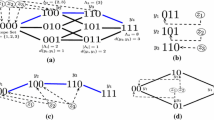Abstract
This paper analyzes the role of neutral viruses in the phenomenon of local immunodeficiency. We show that, even in the absence of altruistic viruses, neutral viruses can support the existence of persistent viruses and thus local immunodeficiency. However, in all such cases neutral viruses can maintain only bounded (relatively small) concentration of persistent viruses. Moreover, in all such cases the state of local immunodeficiency could only be marginally stable, while it is known that altruistic viruses can maintain stable local immunodeficiency. We also present an absolutely minimal cross-immunoreactivity network where a stable and robust state of local immunodeficiency can be maintained. It is now a challenge to synthetic biology to build such small networks with stable local immunodeficiency. Another important challenge for biology is to understand which types of viruses can play a role of persistent, altruistic and neutral ones and whether a role which a given virus plays depends on the structure (topology) of a given cross-immunoreactivity network.






Similar content being viewed by others
References
Bunimovich L, Shu L (2019) Local immunodeficiency: minimal networks and stability. Math Biosci 310:31–49
Campo DS, Dimitrova Z, Yamasaki L, Skums P, Lau DT, Vaughan G, Forbi JC, Teo C-G, Khudyakov Y (2014) Next-generation sequencing reveals large connected networks of intra-host HCV variants. BMC Genom 15(Suppl 5):S4
Chicone C (2006) Ordinary differential equations with applications. Springer, New York
Dahari H, Layden-Almer JE, Kallwitz E, Rebeiro RM, Cotler SJ, Layden TJ, Perelson AS (2009) A mathematical model of hepatitis C virus dynamics in patients with high baseline viral loads or advanced liver disease. Gastroentorology 136(4):1402–1409
Domingo-Calap P, Segredo-Otero E, Duran-Moreno M, Sanjuan R (2019) Social evolution of innate immunity evasion in a virus. Nat Microbiol 4:1006–1013
Francis T Jr (1960) On the doctrine of original antigenic sin. Proc Am Philos Soc 104(6):572–578
Hattori M, Yashioka K, Aiyama T, Iwata K, Terazawa Y, Ishigami M, Yano M, Kakumu S (1998) Broadly reactive antibodies to hypervariable region 1 in hepatitis C virus-infected patient sera: relation to viral loads and response to interferon. Hepatology 27(6):1703–1710
Kim JH, Skountzou I, Compans R, Jacob J (2009) Original antigenic sin responses to influenza viruses. J Immunol 183(5):3294–3301
Midgley CM, Bajwa-Joseph M, Vasanawathana S, Limpitikul W, Wills B, Flanagan A, Waiyaiya E, Tran HB, Cowper AE, Chotiyarnwon P, Grimes JM, Yoksan S, Malasit P, Simmons CP, Mongkolsapaya J, Screaton GR (2011) An in-depth analysis of original antigenic sin in dengue virus infection. J Virol 85(1):410–421
Nowak MA, May RM (1991) Mathematical biology of HIV infections: antigenic variation and diversity threshold. Math Biosci 106(1):1–21
Nowak MA, May RM (2000) Virus dynamics: mathematical principles of immunology and virology. Oxford University Press, Oxford
Nowak MA, May RM, Anderson RM (1990) The evolutionary dynamics of HIV-1 quasispecies and the development of immunodeficiency disease. AIDS 4(11):1095–1103
Nowak MA, Anderson RM, Mclean AR, May RM (1991) Antigenic diversity thresholds and the development of aids. Science 254(5034):963–969
Pan K (2011) Understanding original antigenic sin in influenza with a dynamical system. PLoS ONE 6(8):e23910
Parsons MS, Muller S, Kholer H, Grant MD, Bernard NF (2013) On the benefits of sin:can greater understanding of the 1f7-idiotypic repertoire freeze enhance HIV vaccine development? Hum Vaccines Immunother 9(7):1532–1538
Rehermann B, Shin E-C (2005) Private aspects of heterologous immunity. J Exp Med 201(5):667–670
Rong L, Dahari H, Ribeiro RM, Perelson AS (2010) Rapid emergence of protease inhibitor resistance in hepatitis C virus. Sci Transl Med 2(30):30ra32
Skums P, Bunimovich L, Khudyakov Y (2015) Antigenic cooperation among intrahost HCV variants organized into a complex network of cross-immunoreactivity. Proc Natl Acad Sci USA 112(21):6653–6658
Wodarz D (2003) Hepatitis C virus dynamics and pathology: the role of CTL and antibody responses. J Gener Virol 84(Pt 7):1743–1750
Yoshioka K, Aiyama T, Okumura A, Takayanagi M, Iwata K, Ishikawa T, Nagai Y, Kakumu S (1997) Humoral immune response to the hypervariable region of hepatitis C virus differs between genotypes 1b and 2a. J Infect Dis 175(3):505–510
Acknowledgements
The authors are indebted to P. Skums for valuable discussions. This work was partially supported by the NSF Grant CCF-BSF-1664836 and by the NIH Grant 1R01EB025022.
Author information
Authors and Affiliations
Corresponding author
Additional information
Publisher's Note
Springer Nature remains neutral with regard to jurisdictional claims in published maps and institutional affiliations.
Appendices
Appendix A. Computation of \(P(\lambda )\) from the Characteristic Polynomial of the Jacobian for Fig. 1
Appendix B. Computation of the Characteristic Polynomial of the Jacobian for Fig. 3
Let \(\lambda _1=\frac{cx_1}{\alpha r_2}-b\),
Appendix C. Computation of the Characteristic Polynomial of the Jacobian for Fig. 4
Let \(\lambda _1=\frac{cx_1}{\alpha (r_2+r_3)}-b<\frac{b}{\alpha }-b\), then

By expanding along the fourth row, we get
Expanding now along the second row, we obtain
where
Rights and permissions
About this article
Cite this article
Bunimovich, L., Shu, L. Local Immunodeficiency: Role of Neutral Viruses. Bull Math Biol 82, 140 (2020). https://doi.org/10.1007/s11538-020-00813-z
Received:
Accepted:
Published:
DOI: https://doi.org/10.1007/s11538-020-00813-z




